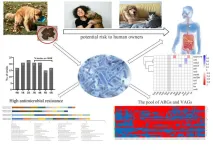(Press-News.org) BUFFALO, N.Y. — Drug discovery can be a frustrating process of trial and error.
Scientists using fragment-based drug discovery link fragments of different molecules together to create a more potent drug but may not know whether a compound works until millions of dollars in research and development have already been spent.
New University at Buffalo research may offer a more streamlined approach, allowing drug makers to determine the viability of a fragment-based design earlier in the process.
While developing a fragment-based drug to treat lung cancer, a team co-led by UB found that where they linked fragments together had a large effect on potency.
“Despite consisting of the same molecule fragments, we found that one of our compounds was superadditive, while the other was virtually inactive. The main difference between the two was the points at which their fragments were linked together,” says David Heppner, PhD, Jere Solo Assistant Professor of medicinal chemistry in the UB College of Arts and Sciences and co-senior author of the study, which published Feb. 20 in Communications Chemistry, an open-access Nature Portfolio Journal.
Molecule fragments are often linked together using another molecule, typically called linkers. Much attention is paid to their length and the kinds of atoms inside, while their placement on fragments, or the points of connection, is often left up to chance.
But Heppner and his team say that determining the optimal point of connection at the onset, while perhaps cumbersome, is most efficient.
“We believe our approach adds more intelligence to the drug optimization process and minimizes the amount of work needed to find the most potent structure,” says co-lead author Blessing Ogboo, a PhD student in Heppner’s lab.
The stakes are high in drug discovery: It’s estimated that it takes on average 12 years and $2.7 billion to develop a new drug. Most drugs never even make it to the market — for example, 97% of cancer drugs fail clinical trials.
Fragment-based drug discovery, or FBDD, has become a sought-after method. Linked fragments can bind to a drug target, like a protein or enzyme, at multiple sites simultaneously, making them more potent than their parent molecules would be on their own.
The UB team was using FBDD to develop inhibitors that can bind to multiple sites on the kinase domain of the epidermal growth factor receptor (EGFR), a key protein in non-small cell lung cancer. One of their inhibitors was linked to a central group, while the other was connected through an outer region of the molecule.
When tested on an EGFR in a cell culture, the inhibitor linked through an outer region was more than 1 million times more potent.
Curious to understand why, the team used x-ray crystallography and molecular dynamic simulations to determine the two inhibitors’ 3-D structure and how they bind to EGFR.
The tools showed that the superior potency was due to the placement of its linker allowing for greater mobility and better compatibility with the EGFR’s binding site. They also ruled out more conventional attributes — length and atom type — being behind the increased potency.
“Previous studies have highlighted the importance of flexibility for linkers, but we believe our inhibitors are unique given their wide range of potency despite relatively small differences in linker structure,” says co-lead author Stefan Laufer, PhD, of the Eberhard Karls University of Tübingen.
Other co-authors from UB include Tahereh Damghani, PhD, a postdoctoral research associate; Surbhi Chitnis, a PhD student; and former graduate students Calvin Pham and Brandon Oligny. Other contributors represent Roswell Park Comprehensive Cancer Center, Harvard Medical School, the University of Eastern Finland, and AssayQuant Technologies, Inc.
Heppner and Laufer’s teams have filed both a U.S. and international patent application on the EGFR inhibitors and are working with UB’s Technology Transfer office.
The Heppner lab recently led another study on covalent EGFR inhibitors that was published in the Journal of Medicinal Chemistry. Written in collaboration industry partners, it serves as a perspective on best practices, as well as common pitfalls in drug development.
“We hope our recent studies and others like them can better inform decision making in the drug discovery process, creating cost savings and decreasing time to new therapies,” Heppner says.
Both studies were supported by the National Institutes of Health.
END
Study proposes streamlined approach to developing cancer drugs
Findings suggest placement of molecular linkers should be determined earlier on in drug discovery
2024-02-28
ELSE PRESS RELEASES FROM THIS DATE:
New study finds high-dose inhaled nitric oxide decreases the risk of death among critically ill Black patients with COVID-19
2024-02-28
In a first-of-its-kind study published in the American Journal of Respiratory and Critical Care Medicine, physician-scientists from the University of Alabama at Birmingham Marnix E. Heersink School of Medicine discovered that high-dose inhaled nitric oxide therapy may improve oxygenation and reduce the risk of mortality among critically ill Black patients with COVID-19.
Acute respiratory distress syndrome, or ARDS, is a condition that most commonly occurs in the setting of a lung infection such as COVID-19.
“In ARDS, the barrier between the blood vessels and air sacs in the lungs is disrupted leading to the accumulation of fluid ...
Ochsner Digital Medicine Partners with Humana Healthy Horizons
2024-02-28
New Orleans, LA. – Ochsner Digital Medicine has partnered with Humana Healthy Horizons to provide digital medicine services to its members. This agreement was effective February 1, 2024, with member enrollment in digital programs available immediately after.
Humana Healthy Horizons is Humana’s Medicaid plan for Louisiana, covering thousands of members throughout the state. Through this partnership, Ochsner Digital Medicine will offer Humana Healthy Horizons members who have been diagnosed with Hypertension and Type 2 diabetes remote programs designed to manage and control their conditions.
The programs use remote patient management through digital devices and personalized ...
Vision Zero road safety projects in Seattle are unlikely to have negative impacts on local business sales, UW study finds
2024-02-28
Seattle is routinely listed as one of the most walkable and bike-friendly cities in the nation. The city government has committed to Vision Zero, which aims to completely eliminate traffic deaths and serious injuries by 2030, and embarked on a slew of infrastructure projects: expanding the city’s bike network, redesigning high-crash intersections and enhancing crosswalks to protect pedestrians.
Such safety projects sometimes meet opposition from local business owners, who worry that reduced parking and disruption ...
African great apes predicted to see frequent extreme climate events in the next 30 years
2024-02-28
African apes are already being exposed to climate change impacts, and will experience extreme events such as wildfires, heatwaves and flooding more frequently in the next 30 years, according to a study publishing February 28 in the open-access journal PLOS Climate by Razak Kiribou at Haramaya University in Ethiopia and colleagues.
To better understand how African great apes will be affected by climate change, researchers investigated past and future climate for 363 sites across Africa. They estimated temperature and rainfall at each site between 1981 and 2010. Using two climate change scenarios, they projected how frequently apes would be exposed to climate change impacts in the near ...
EU countries have seen a decade of progress towards their 2030 sustainable energy goal
2024-02-28
Countries in the European Union (EU) have made progress over the past decade toward Sustainable Development Goal 7 (SDG 7), which calls for “access to affordable, reliable, sustainable and modern energy for all” by 2030, according to a study published February 28, 2024 in the open-access journal PLOS ONE by Marek Walesiak from Wroclaw University of Economics and Business, Poland, and Grażyna Dehnel from Poznań University of Economics and Business, Poland.
In 2015, the United Nations developed 17 global Sustainable Development Goals to be achieved by 2030. Tenets of SDG 7 include universal access to affordable energy; increased renewable energy ...
Climate change threatens thousands of archaeological sites in coastal Georgia
2024-02-28
Thousands of historic and archaeological sites in Georgia are at risk from tropical storm surges, and that number will increase with climate change, according to a study published February 28, 2024 in the open-access journal PLOS ONE by Matthew D. Howland and Victor D. Thompson of Wichita State University and the University of Georgia.
Anthropogenic climate change poses a major risk to coastlines due to rising sea level and increasingly severe tropical storms. This threatens not only living populations but also historic and archaeological sites. Mitigating damage requires accurate assessments of risks, but most predictive models focus on projected ...
Pet dogs with diarrhea may be shedding multi-drug resistant E.coli in 5 in 10 cases, with potential risks to their human owners
2024-02-28
Pet dogs with diarrhea may be shedding multi-drug resistant E.coli in 5 in 10 cases, with potential risks to their human owners
###
Article URL: https://journals.plos.org/plosone/article?id=10.1371/journal.pone.0298053
Article Title: Characteristics of MDR E. coli strains isolated from Pet Dogs with clinic diarrhea: A pool of antibiotic resistance genes and virulence-associated genes
Author Countries: China
Funding: This research was funded by the National Key Research and Development Program of China (2018YFD0500900, ...
Harassment on public transport negatively impacts women's health and welfare, with existing measures being largely ineffective, per systematic review
2024-02-28
Harassment on public transport negatively impacts women's health and welfare, with existing measures being largely ineffective, per systematic review
###
Article URL: https://journals.plos.org/plosone/article?id=10.1371/journal.pone.0296830
Article Title: Invasion of privacy or structural violence? Harassment against women in public transport environments: A systematic review
Author Countries: Spain
Funding: This study has been supported by the research grant ACIF/2020/035 from the "Generalitat Valenciana". The funding entity did not contribute to the study design or data collection, analysis, interpretation, or writing the manuscript. There was no additional ...
How the SARS-CoV-2 virus acquires its spherical shape
2024-02-28
RIVERSIDE, Calif. -- For centuries, coronaviruses have triggered health crises and economic challenges, with SARS-CoV-2, the coronavirus that spreads COVID-19, being a recent example. One small protein in SARS-CoV-2, the Membrane protein, or M protein, is the most abundant and plays a crucial role in how the virus acquires its spherical structure. Nonetheless, this protein’s properties are not well understood.
A research team led by a physicist at the University of California, Riverside, has devised a new method to make large quantities of M protein, and has characterized the protein’s ...
A step toward personalized immunotherapy for all
2024-02-28
LA JOLLA, CA—Most cancers are thought to evade the immune system. These cancers don't carry very many mutations, and they aren’t infiltrated by cancer-fighting immune cells. Scientists call these cancers immunologically "cold."
Now new research suggests such cancers aren't as "cold" as once thought. Researchers from the La Jolla Institute for Immunology (LJI), UC San Diego Moores Cancer Center, and UC San Diego, have found that patients with "cold" tumors actually do make cancer-fighting T cells.
This discovery opens the door to developing vaccines or therapies to increase T cell ...
LAST 30 PRESS RELEASES:
Tracing the quick synthesis of an industrially important catalyst
New software sheds light on cancer’s hidden genetic networks
UT Health San Antonio awarded $3 million in CPRIT grants to bolster cancer research and prevention efforts in South Texas
Third symposium spotlights global challenge of new contaminants in China’s fight against pollution
From straw to soil harmony: International team reveals how biochar supercharges carbon-smart farming
Myeloma: How AI is redrawing the map of cancer care
Manhattan E. Charurat, Ph.D., MHS invested as the Homer and Martha Gudelsky Distinguished Professor in Medicine at the University of Maryland School of Medicine
Insilico Medicine’s Pharma.AI Q4 Winter Launch Recap: Revolutionizing drug discovery with cutting-edge AI innovations, accelerating the path to pharmaceutical superintelligence
Nanoplastics have diet-dependent impacts on digestive system health
Brain neuron death occurs throughout life and increases with age, a natural human protein drug may halt neuron death in Alzheimer’s disease
SPIE and CLP announce the recipients of the 2025 Advanced Photonics Young Innovator Award
Lessons from the Caldor Fire’s Christmas Valley ‘Miracle’
Ant societies rose by trading individual protection for collective power
Research reveals how ancient viral DNA shapes early embryonic development
A molecular gatekeeper that controls protein synthesis
New ‘cloaking device’ concept to shield sensitive tech from magnetic fields
Researchers show impact of mountain building and climate change on alpine biodiversity
Study models the transition from Neanderthals to modern humans in Europe
University of Phoenix College of Doctoral Studies releases white paper on AI-driven skilling to reduce burnout and restore worker autonomy
AIs fail at the game of visual “telephone”
The levers for a sustainable food system
Potential changes in US homelessness by ending federal support for housing first programs
Vulnerability of large language models to prompt injection when providing medical advice
Researchers develop new system for high-energy-density, long-life, multi-electron transfer bromine-based flow batteries
Ending federal support for housing first programs could increase U.S. homelessness by 5% in one year, new JAMA study finds
New research uncovers molecular ‘safety switch’ shielding cancers from immune attack
Bacteria resisting viral infection can still sink carbon to ocean floor
Younger biological age may increase depression risk in older women during COVID-19
Bharat Innovates 2026 National Basecamp Showcases India’s Most Promising Deep-Tech Ventures
Here’s what determines whether your income level rises or falls
[Press-News.org] Study proposes streamlined approach to developing cancer drugsFindings suggest placement of molecular linkers should be determined earlier on in drug discovery








